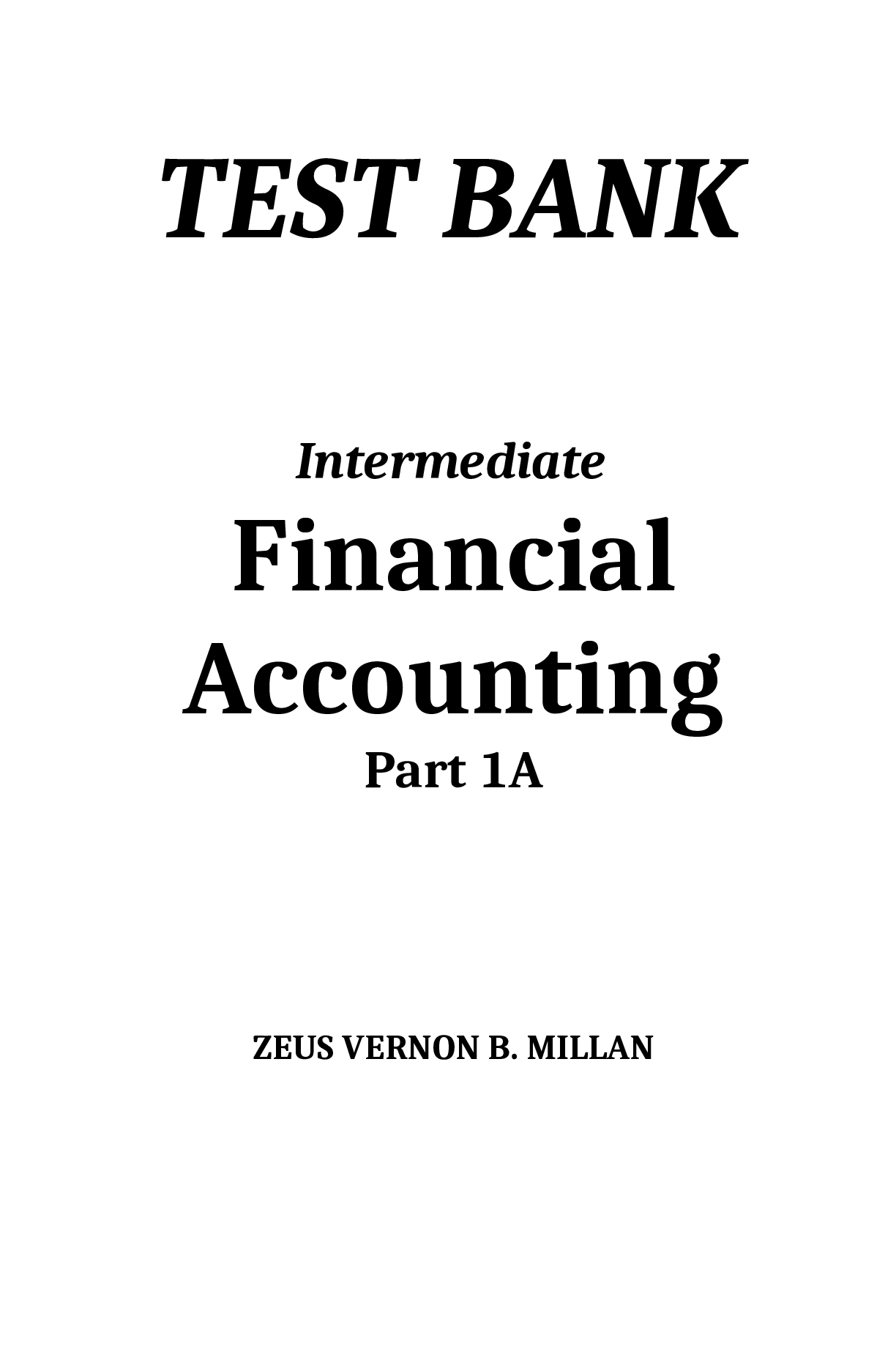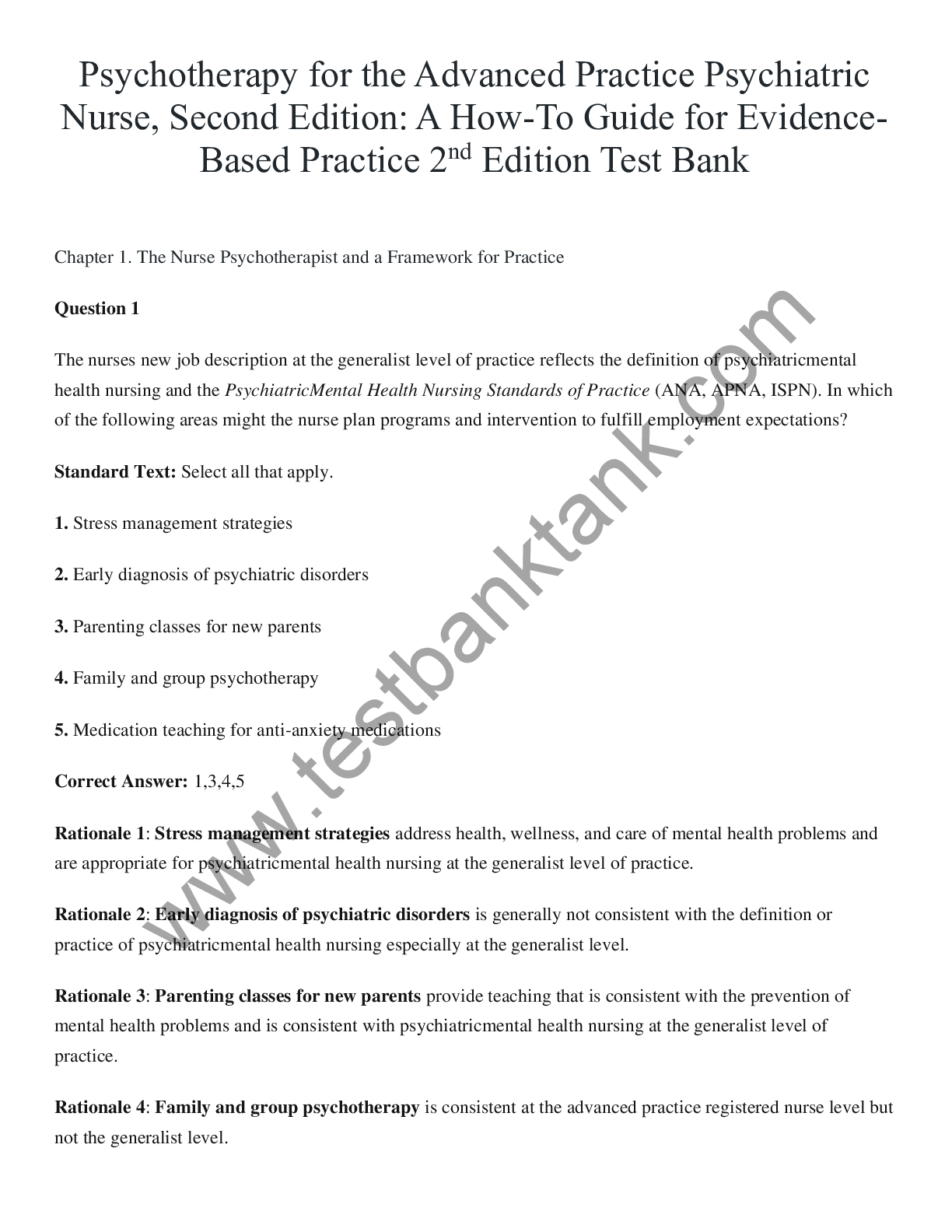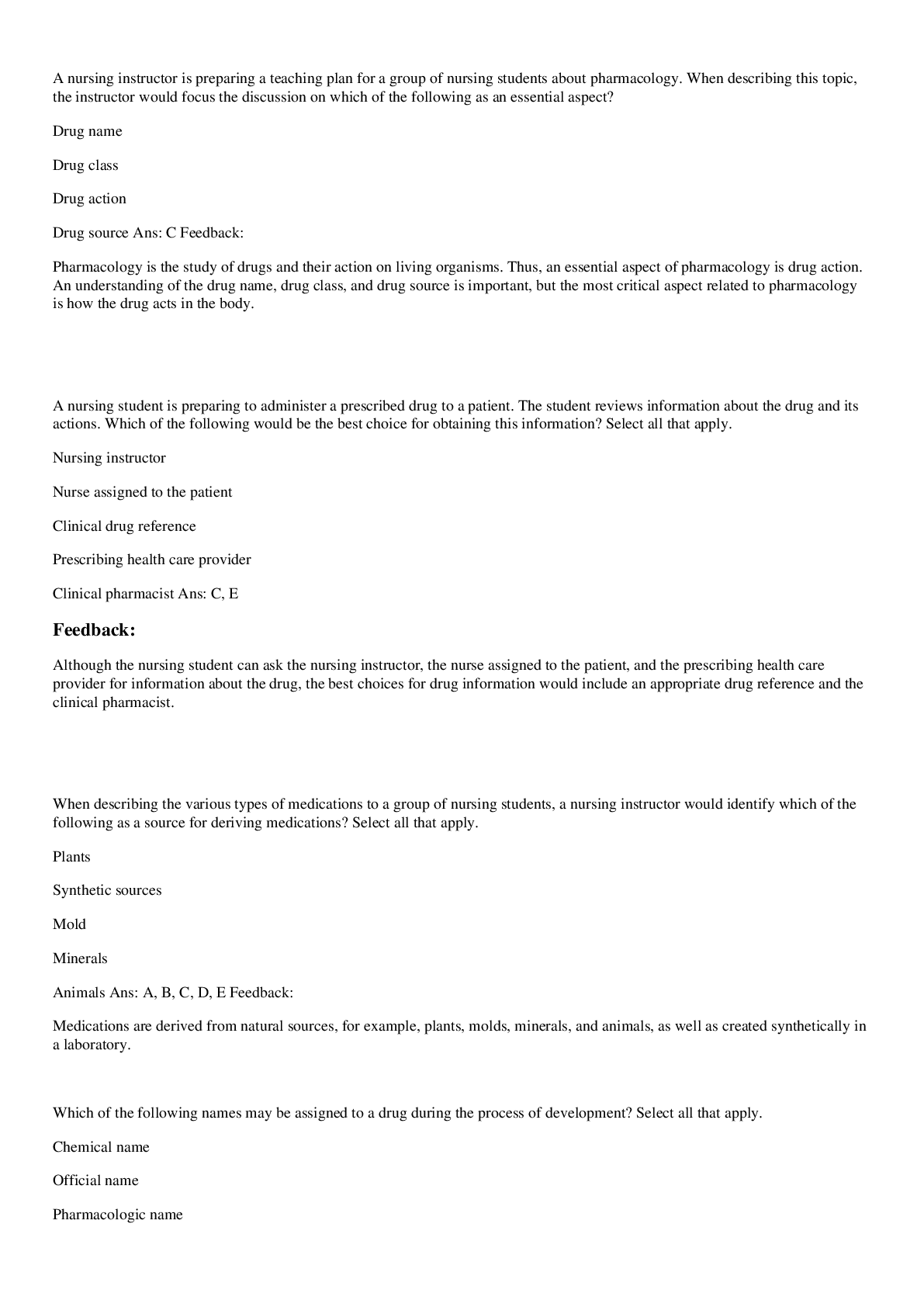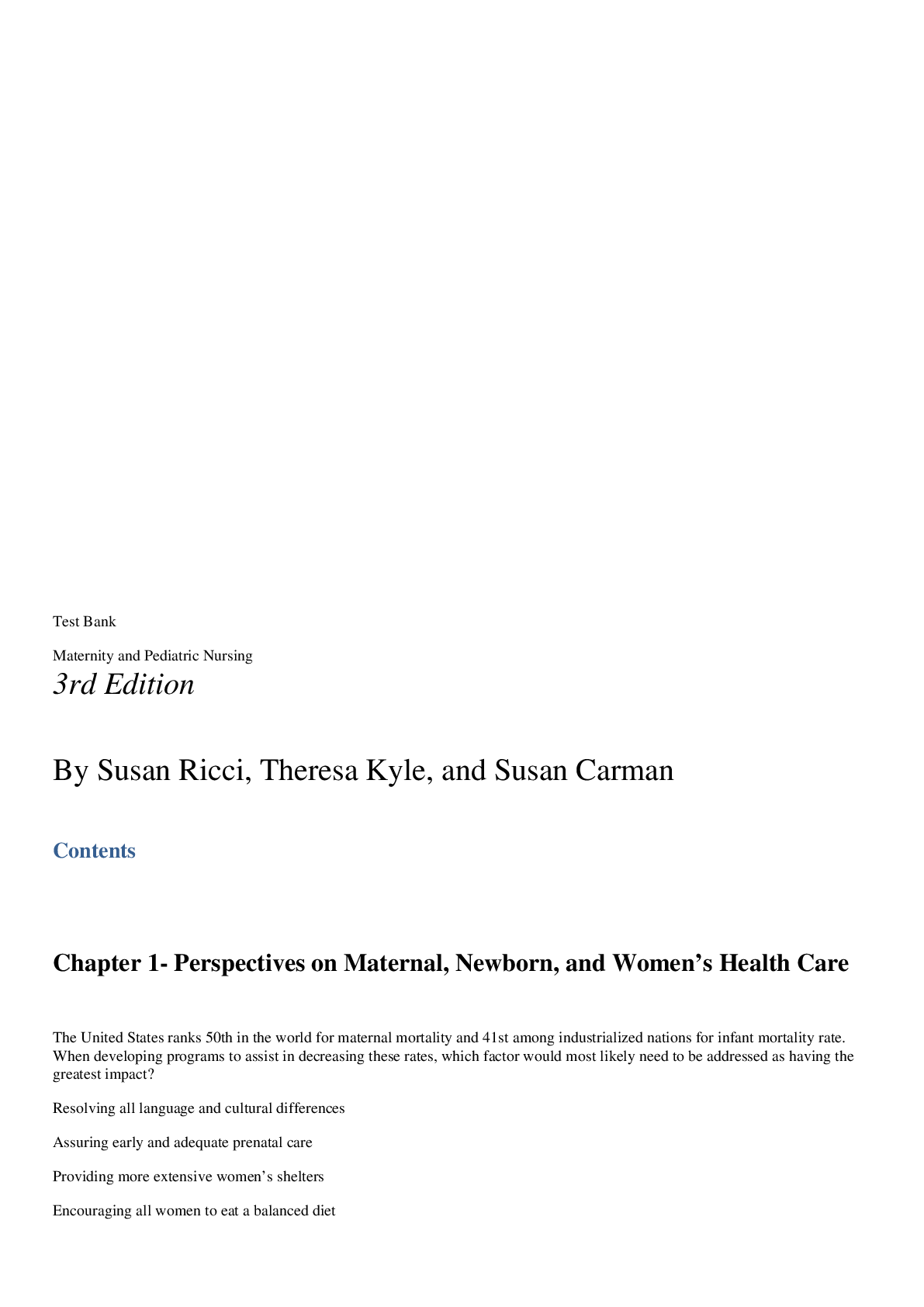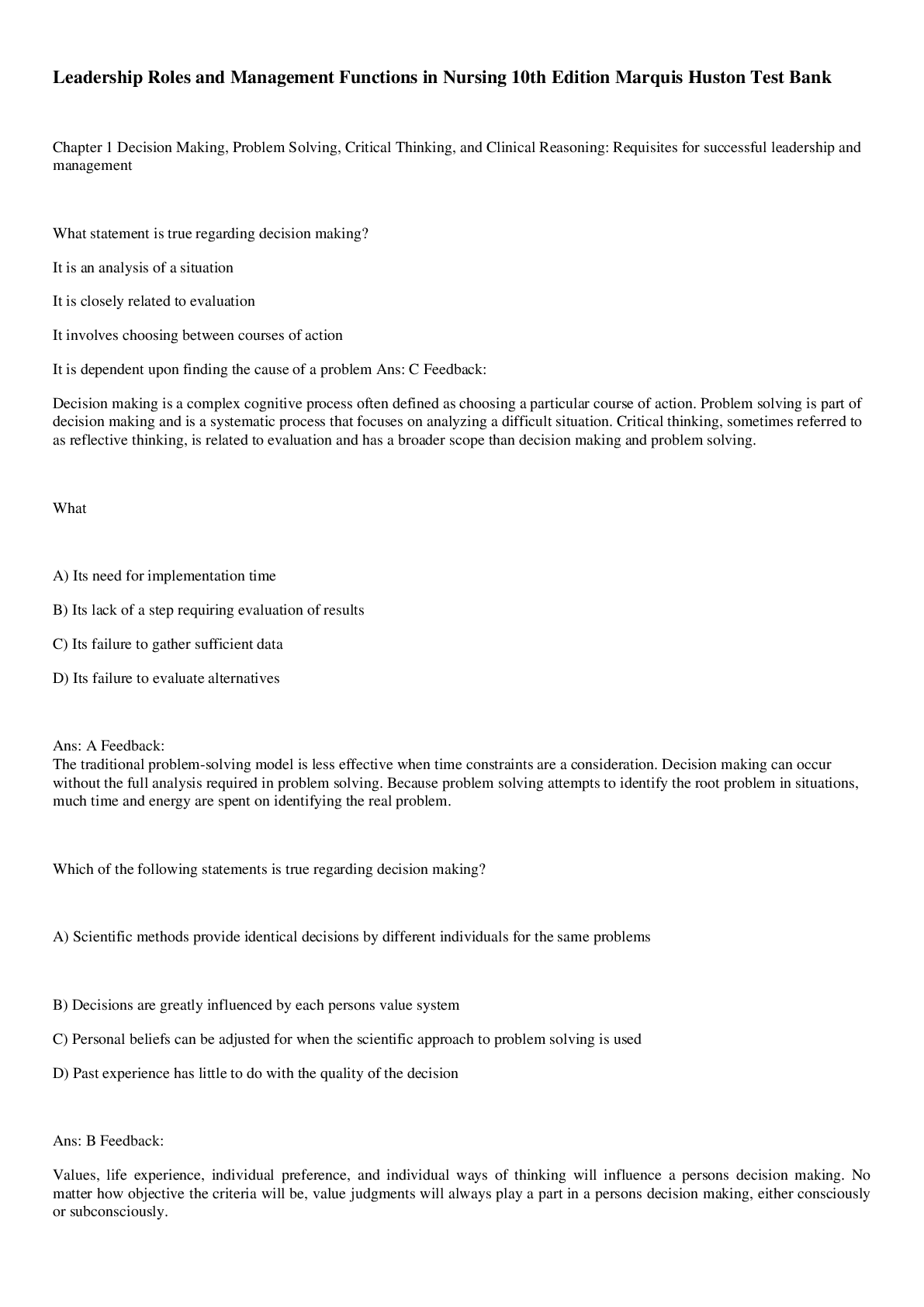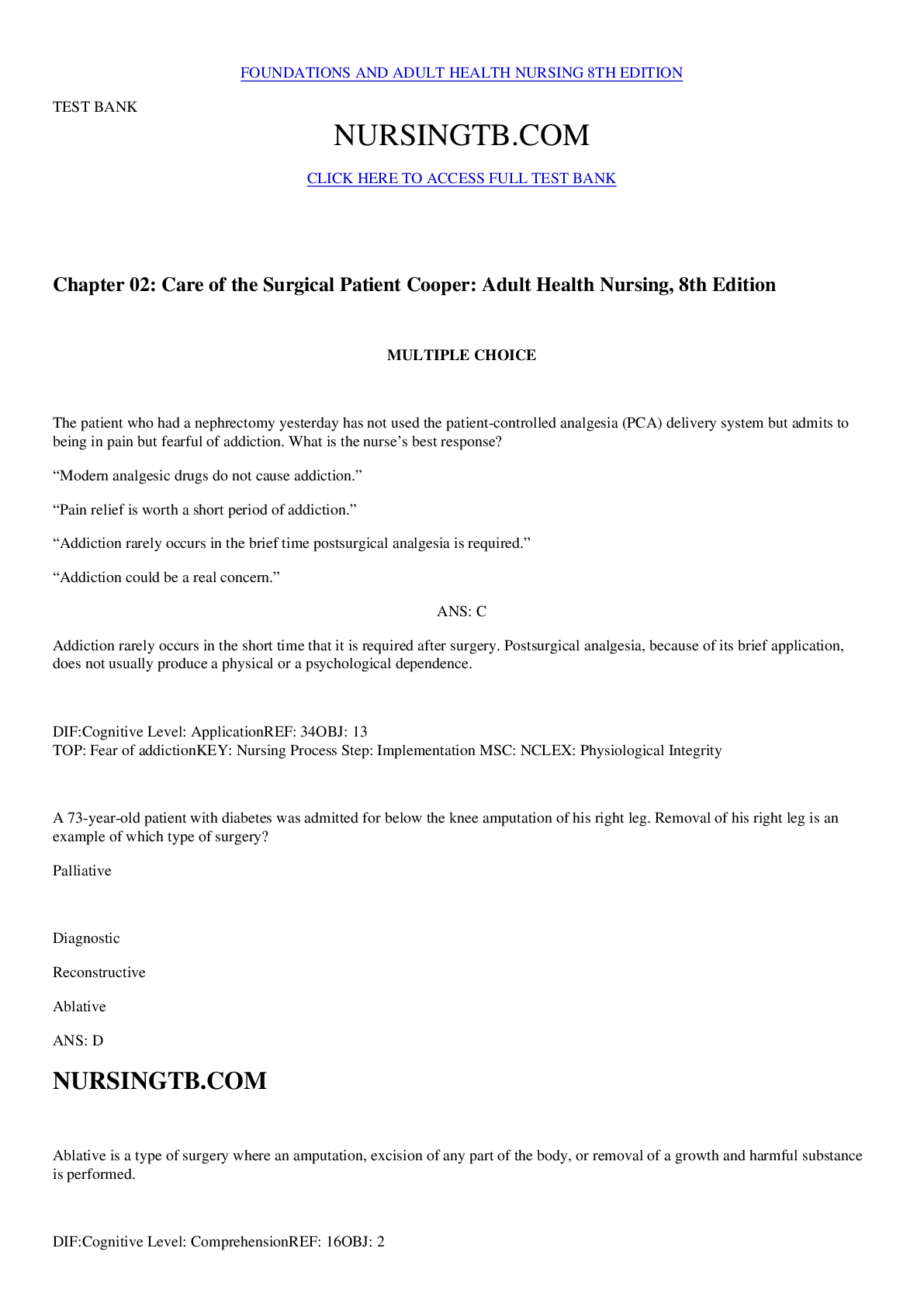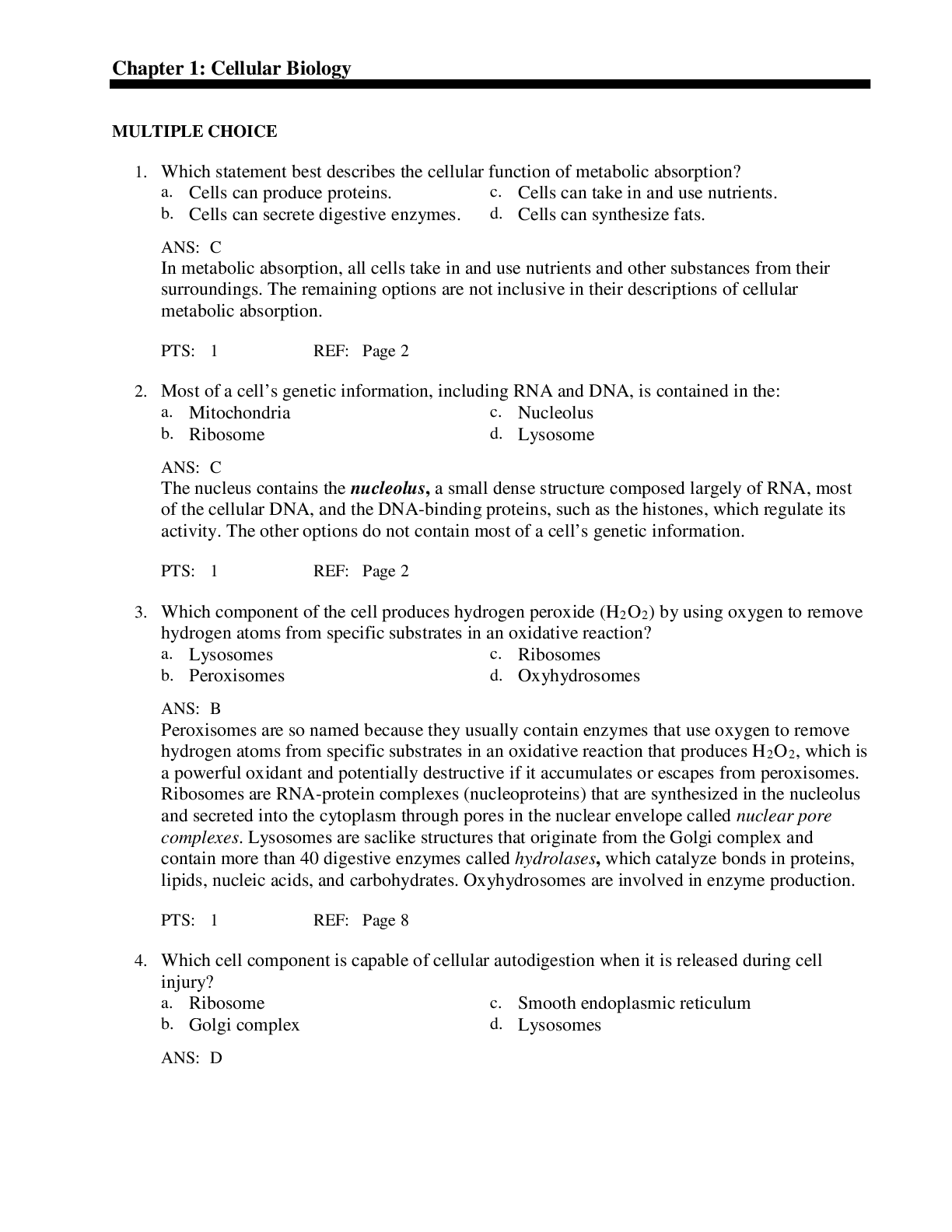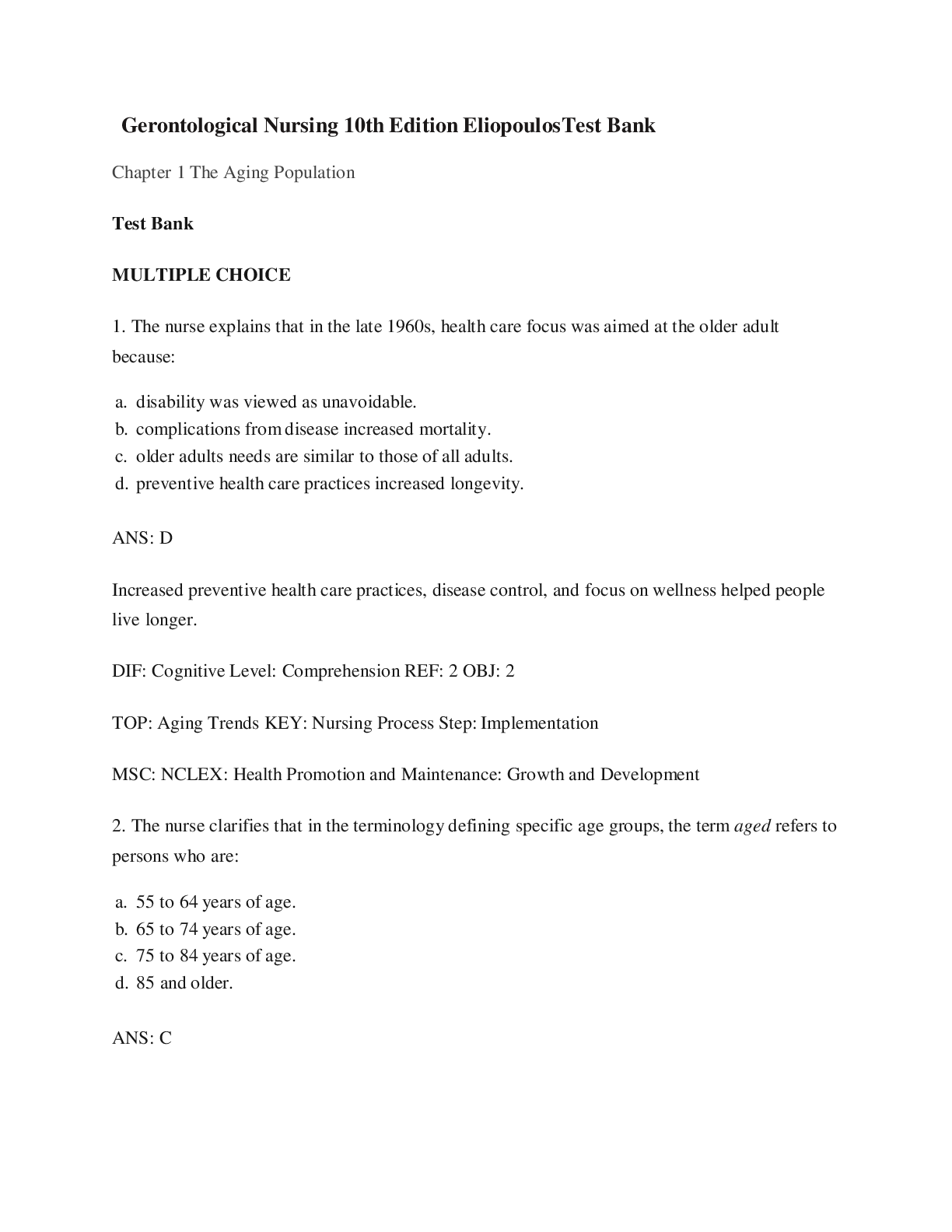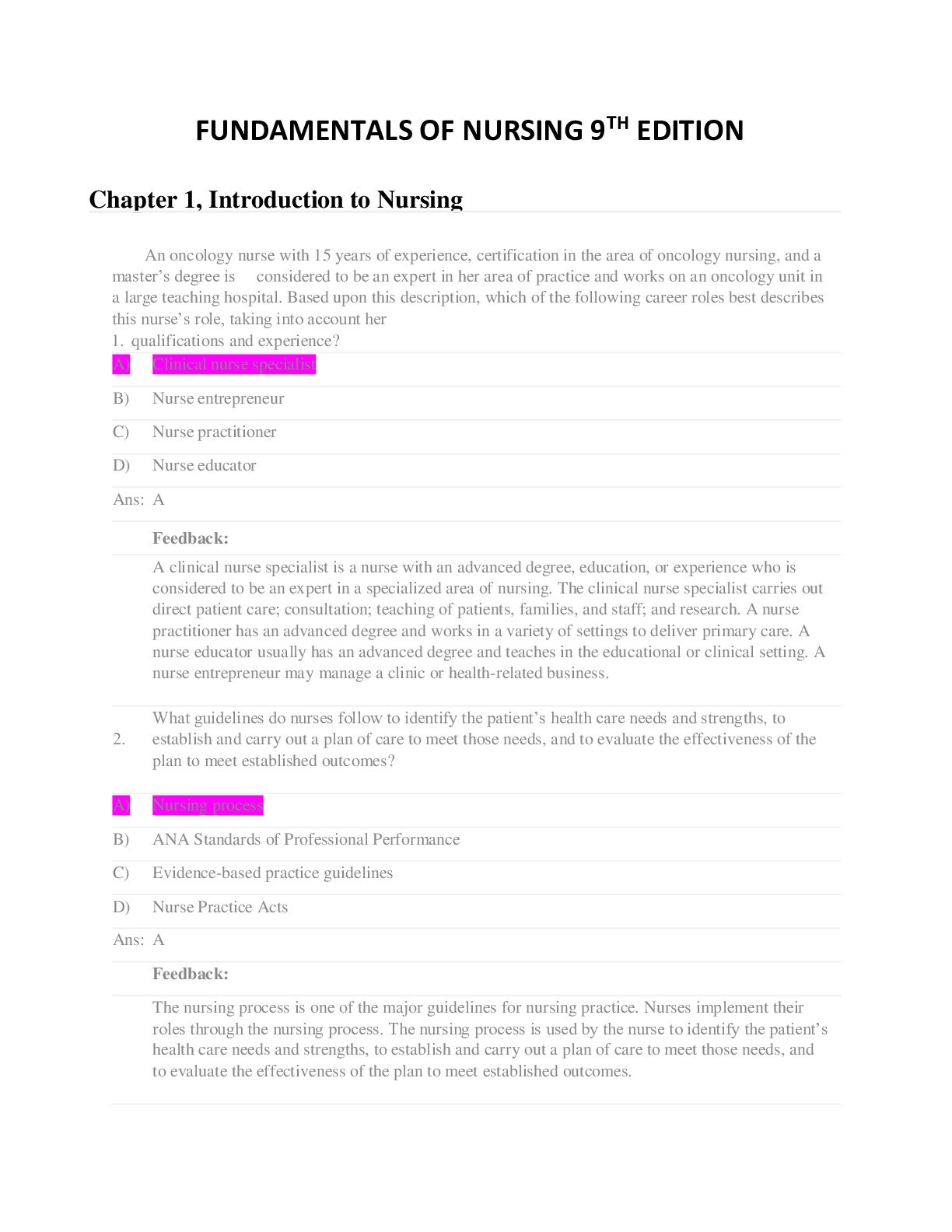*NURSING > TEST BANK > TestBank-McCance-Pathophysiology-Biologic-Basis-for-Disease-8th-2021 > complete A+ guide; all chapte (All)
TestBank-McCance-Pathophysiology-Biologic-Basis-for-Disease-8th-2021 > complete A+ guide; all chapters questions/answers(deeply elaborated)
Document Content and Description Below
TEST BANK PATHOPHYSIOLOGY THE BIOLOGIC BASIS FOR DISEASE IN ADULTS AND CHILDREN 8th Edition Kathryn L. McCance, Sue E. Huether2 Contents Chapter 01: Cellular Biology................................ ............................................................................................. 4 Chapter 02: Altered Cellular and Tissue Biology: Environmental Agents...................................................18 Chapter 03: The Cellular Environment: Fluids and Electrolytes, Acids and Bases......................................31 Chapter 04: Genes and Genetic Diseases ...................................................................................................44 Chapter 05: Genes, Environment-Lifestyle, and Common Diseases...........................................................55 Chapter 06: Epigenetics and Disease..........................................................................................................63 Chapter 07: Innate Immunity: Inflammation and Wound Healing.............................................................68 Chapter 08: Adaptive Immunity..................................................................................................................83 Chapter 09: Alterations in Immunity and Inflammation.............................................................................95 Chapter 10: Infection ................................................................................................................................108 Chapter 11: Stress and Disease.................................................................................................................117 Chapter 12: Cancer Biology.......................................................................................................................124 Chapter 13: Cancer Epidemiology.............................................................................................................137 Chapter 14: Cancer in Children.................................................................................................................143 Chapter 15: Structure and Function of the Neurologic System................................................................148 Chapter 16: Pain, Temperature Regulation, Sleep, and Sensory Function...............................................159 Chapter 17: Alterations in Cognitive Systems, Cerebral Hemodynamics, and Motor Function...............174 Chapter 18: Disorders of the Central and Peripheral Nervous Systems and the Neuromuscular Junction ..................................................................................................................................................................188 Chapter 19: Neurobiology of Schizophrenia, Mood Disorders, and Anxiety Disorders ...........................199 Chapter 20: Alterations of Neurologic Function in Children.....................................................................206 Chapter 21: Mechanisms of Hormonal Regulation...................................................................................213 Chapter 22: Alterations of Hormonal Regulation .....................................................................................222 Chapter 23: Obesity and Disorders of Nutrition .......................................................................................234 Chapter 24: Structure and Function of the Reproductive Systems ..........................................................239 Chapter 25: Alterations of the Female Reproductive System ..................................................................249 Chapter 26: Alterations of the Male Reproductive System ......................................................................259 Chapter 27: Sexually Transmitted Infections............................................................................................265 Chapter 28: Structure and Function of the Hematologic System.............................................................273 Chapter 29: Alterations of Erythrocytes, Platelets, and Hemostatic Function.........................................2833 Chapter 30: Alterations of Leukocyte and Lymphoid Function ................................................................293 Chapter 31: Alterations of Hematologic Function in Children..................................................................300 Chapter 32: Structure and Function of the Cardiovascular and Lymphatic Systems ...............................311 Chapter 33: Alterations of Cardiovascular Function.................................................................................324 Chapter 34: Alterations of Cardiovascular Function in Children ..............................................................338 Chapter 35: Structure and Function of the Pulmonary System................................................................346 Chapter 36: Alterations of Pulmonary Function .......................................................................................356 Chapter 37: Alterations of Pulmonary Function in Children.....................................................................373 Chapter 38: Structure and Function of the Renal and Urologic Systems .................................................381 Chapter 39: Alterations of Renal and Urinary Tract Function ..................................................................391 Chapter 40: Alterations of Renal and Urinary Tract Function in Children ................................................401 Chapter 41: Structure and Function of the Digestive System...................................................................409 Chapter 42: Alterations of Digestive Function..........................................................................................421 Chapter 43: Alterations of Digestive Function in Children .......................................................................432 Chapter 44: Structure and Function of the Musculoskeletal System .......................................................441 Chapter 45: Alterations of Musculoskeletal Function ..............................................................................453 Chapter 46: Alterations of Musculoskeletal Function in Children............................................................466 Chapter 47: Structure, Function, and Disorders of the Integument.........................................................475 Chapter 48: Alterations of the Integument in Children............................................................................486 Chapter 49: Shock, Multiple Organ Dysfunction Syndrome, and Burns in Adults....................................494 Chapter 50: Shock, Multiple Organ Dysfunction Syndrome, and Burns in Children ................................502Test Bank - Pathophysiology: The Biologic Basis for Disease in Adults and Children (8th) 4 Chapter 01: Cellular Biology MULTIPLE CHOICE 1. Which statement best describes the cellular function of metabolic absorption? a. Cells can produce proteins. b. Cells can secrete digestive enzymes. c. Cells can take in and use nutrients. d. Cells can synthesize fats. ANS: C In metabolic absorption, all cells take in and use nutrients and other substances from their surroundings. The remaining options are not inclusive in their descriptions of cellular metabolic absorption. PTS: 1 DIF: Cognitive Level: Remembering 2. Where is most of a cell’s genetic information, including RNA and DNA, contained? a. Mitochondria b. Ribosome c. Nucleolus d. Lysosome ANS: C The nucleus contains the nucleolus, a small dense structure composed largely of RNA, most of the cellular DNA, and the DNA-binding proteins, such as the histones, which regulate its activity. The mitochondria are responsible for cellular respiration and energy production. Ribosomes’ chief function is to provide sites for cellular protein synthesis. Lysosomes function as the intracellular digestive system. PTS: 1 DIF: Cognitive Level: Remembering 3. Which component of the cell produces hydrogen peroxide (H2O2) by using oxygen to remove hydrogen atoms from specific substrates in an oxidative reaction? a. Lysosomes b. Peroxisomes c. Ribosomes d. Endosome ANS: BTest Bank - Pathophysiology: The Biologic Basis for Disease in Adults and Children (8th) 5 Peroxisomes are so named because they usually contain enzymes that use oxygen to remove hydrogen atoms from specific substrates in an oxidative reaction that produces H2O2, which is a powerful oxidant and potentially destructive if it accumulates or escapes from peroxisomes. Ribosomes are RNA-protein complexes (nucleoproteins) that are synthesized in the nucleolus and secreted into the cytoplasm through pores in the nuclear envelope called nuclear pore complexes. Lysosomes are saclike structures that originate from the Golgi complex and contain more than 40 digestive enzymes called hydrolases, which catalyze bonds in proteins, lipids, nucleic acids, and carbohydrates. An endosome is a vesical that has been pinched off from the cellular membrane. PTS: 1 DIF: Cognitive Level: Remembering 4. Which cell component is capable of cellular autodigestion when it is released during cell injury? a. Ribosome b. Golgi complex c. Smooth endoplasmic reticulum d. Lysosomes ANS: D The lysosomal membrane acts as a protective shield between the powerful digestive enzymes within the lysosome and the cytoplasm, preventing their leakage into the cytoplasmic matrix. Disruption of the membrane by various treatments or cellular injury leads to a release of the lysosomal enzymes, which can then react with their specific substrates, causing cellular selfdigestion. The chief function of a ribosome is to provide sites for cellular protein synthesis. The Golgi complex is a network of flattened, smooth vesicles and membranes often located near the cell nucleus. The smooth endoplasmic reticulum is involved in steroid hormone production and removing toxic substances from the cell. PTS: 1 DIF: Cognitive Level: Remembering 5. Which cAMP-mediated response is related to antidiuretic hormone? a. Increased heart rate and force of contraction b. Secretion of cortisol c. Increased retention of water d. Breakdown of fat ANS: C Antidiuretic hormone leads to increased retention of water in the body. Epinephrine causes increases in heart rate and force of contraction. Increased cortisol secretion is due to ACTH. Breakdown of fat is due to glucagon. PTS: 1 DIF: Cognitive Level: Remembering 6. During which phase of the cell cycle is DNA synthesized? a. G1 b. S c. G2 d. MTest Bank - Pathophysiology: The Biologic Basis for Disease in Adults and Children (8th) 6 ANS: B The four designated phases of the cell cycle are: (1) the G1 phase (G = gap), which is the period between the M phase (M = mitosis) and the start of DNA synthesis; (2) the S phase (S = synthesis), during which DNA is synthesized in the cell nucleus; (3) the G2 phase, during which RNA and protein synthesis occurs, the period between the completion of DNA synthesis and the next phase (M); and (4) the M phase, which includes nuclear and cytoplasmic division. PTS: 1 DIF: Cognitive Level: Remembering 7. What organic compound facilitates transportation across cell membranes by acting as receptors, transport channels for electrolytes, and enzymes to drive active pumps? a. Lipids b. Proteases c. Proteins d. Carbohydrates ANS: C Proteins have several functions, including acting as receptors, transport channels for electrolytes, and enzymes to drive active pumps Lipids help act as the “glue” holding cell membranes together. Proteases cause the breakdown of protein. Carbohydrates are involved in cellular protection and lubrication and help produce energy via oxidative phosphorylation. PTS: 1 DIF: Cognitive Level: Remembering 8. Understanding the various steps of proteolytic cascades may be useful in designing drug therapy for which human diseases? a. Cardiac and vascular disorders b. Autoimmune and malignant disorders c. Gastrointestinal and renal disorders d. Endocrine and gastrointestinal disorders ANS: B Understanding the various steps involved in this process is crucial for designing drug interventions. Dysregulation of proteases features prominently in many human diseases, including cancer, autoimmunity, and neurodegenerative disorders. Cardiac, vascular, gastrointestinal, renal, and endocrine disorders do not involve this process. PTS: 1 DIF: Cognitive Level: Remembering 9. Which structure prevents water-soluble molecules from entering cells across the plasma membrane? a. Carbohydrate chains b. Glycoprotein channels c. Membrane channel proteins d. Lipid bilayer ANS: DTest Bank - Pathophysiology: The Biologic Basis for Disease in Adults and Children (8th) 7 The bilayer’s structure accounts for one of the essential functions of the plasma membrane. It is impermeable to most water-soluble molecules (molecules that dissolve in water) because the water-soluble molecules are insoluble in the oily core region. The bilayer serves as a barrier to the diffusion of water and hydrophilic substances while allowing lipid-soluble molecules, such as oxygen (O2) and carbon dioxide (CO2), to diffuse through it readily. Carbohydrate chains, glycoprotein channels, and membrane channel proteins do not prevent water-soluble molecules from entering cells across the cell membrane. PTS: 1 DIF: Cognitive Level: Remembering 10. A student asks for an explanation of the absolute refractory period of the action potential. What response by the professor is best? a. A stronger than normal impulse will evoke another response. b. No stimulus is able to evoke another response at this time. c. Multiple stimuli can produce more rapid action potentials. d. The hyperpolarized state means a weaker stimulus produces a response. ANS: B During the absolute refractory state of the action potential, no stimulus is able to evoke another response from the cell. A stronger than normal impulse may generate a response in the relative refractory period. This period of time is not related to the number of stimuli. A hyperpolarized state means a stronger than normal stimulus would be needed to generate a response. PTS: 1 DIF: Cognitive Level: Remembering 11. Which form of cell communication is used to communicate within the cell itself and with other cells in direct physical contact? a. Protein channel (gap junction) b. Plasma membrane-bound signaling molecules c. Hormone secretion such as neurotransmitters d. Extracellular chemical messengers such as ligands ANS: B Cells communicate in three main ways; they display plasma membrane-bound signaling molecules that affect the cell itself and other cells in direct physical contact with it, they affect receptor proteins inside the target cell, and they form protein channels (gap junctions) that directly coordinate the activities of adjacent cells. Neurotransmitters are released by neurons and cross the synaptic cleft to communicate with the cells they innervate. Ligands are involved in binding processes. PTS: 1 DIF: Cognitive Level: Remembering 12. Which mode of chemical signaling uses blood to transport communication to cells some distance away? a. Paracrine b. Autocrine c. Neurotransmitter d. HormonalTest Bank - Pathophysiology: The Biologic Basis for Disease in Adults and Children (8th) 8 ANS: D Chemical signaling can be classified into three categories: (1) local-chemical mediator, (2) hormone, and (3) neurotransmitter. Hormones are released by one set of cells and travel through tissues or the bloodstream to another set of cells where they produce a response by those cells. In paracrine signaling, cells secrete local chemical mediators that are quickly absorbed, destroyed, or immobilized. Paracrine signaling requires close membrane-to-membrane contact. Paracrine signaling usually involves different cell types; however, cells also may produce signals that they, themselves, respond to, which is called autocrine signaling. Neurotransmitters are released by neurons and cross the synaptic cleft to communicate with the cells they innervate. PTS: 1 DIF: Cognitive Level: Remembering 13. Which mode of chemical signaling uses local chemical mediators that are quickly taken up, destroyed, or immobilized? a. Paracrine b. Autocrine c. Neurotransmitter d. Hormone ANS: A In paracrine signaling, cells secrete local chemical mediators that are quickly taken up, destroyed, or immobilized. Autocrine signaling occurs when the target cells produce signals that they themselves respond to. Neurotransmitters are released by neurons and cross the synaptic cleft to communicate with the cells they innervate. Hormones are released by one set of cells and travel through tissues or the bloodstream to another set of cells where they produce a response by those cells. PTS: 1 DIF: Cognitive Level: Remembering 14. Neurotransmitters affect the postsynaptic membrane by binding to which structure? a. Lipids b. Ribosomes c. Amphipathic lipids d. Receptors ANS: D In each type of chemical signaling, the target cell receives the signal by first attaching to its receptors. The other options do not correctly describe this process. PTS: 1 DIF: Cognitive Level: Remembering 15. How do cells receive communication from the extracellular fluid surrounding them? a. Protein channel (gap junction) b. Plasma membrane-bound signaling molecules (involving receptors) c. Hormone secretion such as neurotransmitters d. Chemical messengers such as ligands ANS: DTest Bank - Pathophysiology: The Biologic Basis for Disease in Adults and Children (8th) 9 Signal transduction involves incoming signals or instructions from extracellular chemical messengers (ligands) that are conveyed to the cell’s interior for execution. The other options do not correctly describe how cells receive communication from the surrounding extracellular fluid. PTS: 1 DIF: Cognitive Level: Remembering 16. Which molecule provides the second messenger necessary for extracellular communication to be activated? a. Guanosine triphosphate (GTP) b. Adenosine monophosphate (AMP) c. Adenosine triphosphate (ATP) d. Guanosine diphosphate (GDP) ANS: B The two major second-messenger pathways are cyclic AMP (cAMP) and calcium (Ca++). GTP, ATP, and GDP are not major second-messenger pathways. GTP and GDP are “middlemen” or intermediaries. Nutrients are transformed into energy in the form of ATP. PTS: 1 DIF: Cognitive Level: Remembering 17. Under anaerobic conditions, what process provides energy for the cell? a. Oxidative phosphorylation b. Glycolysis c. Lactolysis d. Passive transport ANS: B Glycolysis provides energy to the cells when oxygen delivery is insufficient or delayed. Oxidative phosphorylation is the process by which energy produced from nutrients is transferred to ATP. Lactolysis is the breakdown of lactose. Passive transport is the movement of water and small, nonelectrically charge molecules across plasma membranes. PTS: 1 DIF: Cognitive Level: Remembering 18. What is the mechanism by which the energy produced from carbohydrates, proteins, and lipids is transferred to adenosine triphosphate (ATP)? a. Anaerobic glycolysis b. Oxidative cellular metabolism c. Oxidative phosphorylation d. Tricarboxylic acid phosphorylation ANS: C Oxidative phosphorylation occurs in the mitochondria and is the mechanism by which the energy produced from carbohydrates, fats, and proteins is transferred to ATP. Glycolysis provides energy to the cells when oxygen delivery is insufficient or delayed. Oxidative cellular metabolism and tricarboxylic acid phosphorylation are not involved in transferring energy to ATP. PTS: 1 DIF: Cognitive Level: RememberingTest Bank - Pathophysiology: The Biologic Basis for Disease in Adults and Children (8th) 10 19. Passive transport is best described with which statement? a. Being driven by osmosis, hydrostatic pressure, and diffusion b. Involving receptors that can bind with substances being transported c. Being capable of transporting macromolecules d. Requiring energy generated by the cell ANS: A Water and small electrically uncharged molecules move easily through pores in the plasma membrane’s lipid bilayer. This process, called passive transport, naturally occurs through any semipermeable barrier. It is driven by osmosis, hydrostatic pressure, and diffusion, all of which depend on the laws of physics and do not require life. The other options do not correctly describe passive transport. PTS: 1 DIF: Cognitive Level: Remembering 20. Which is the best example of active transport? a. Movement across a membrane due to differences in solute concentration b. Movement requiring the expenditure of metabolic energy c. Movement of two molecules simultaneously in one direction d. Movement of two molecules simultaneously in opposite directions ANS: B Active transport requires a life, biologic activity, and the expenditure of metabolic energy. Movement due simply to differences in concentration gradients is called passive transport. Movement of two molecules in the same direction is called symport, while moving two molecules in opposite directions is called antiport. PTS: 1 DIF: Cognitive Level: Remembering 21. Which method of transport uses transmembrane proteins with receptors with a high degree of specificity for the substance being transported? a. Active b. Mediated c. Transmembranous d. Passive ANS: B Mediated transport (passive and active) involves integral or transmembrane proteins with receptors having a high degree of specificity for the substance being transported. Active and passive transport are opposites with active transport requiring the use of energy and passive transport relying on osmosis, hydrostatic pressure, and diffusion and not energy. Transmembranous means “across membranes.” PTS: 1 DIF: Cognitive Level: Remembering 22. The movement of fluid across the arterial end of capillary membranes into the interstitial fluid surrounding the capillary is an example of which fluid movement process? a. Hydrostatic pressureTest Bank - Pathophysiology: The Biologic Basis for Disease in Adults and Children (8th) 11 b. Osmosis c. Diffusion d. Active transport ANS: A Hydrostatic pressure is the mechanical force of water pushing against cellular membranes. Osmosis is the movement of water “down” a concentration gradient, that is, across a semipermeable membrane from a region of higher water concentration to a region of lower water concentration. Diffusion is the movement of a solute molecule from an area of greater solute concentration to an area of lesser solute concentration. Active transport requires a life, biologic activity, and the expenditure of metabolic energy. PTS: 1 DIF: Cognitive Level: Remembering 23. A student asks why osmolality is preferred over osmolarity as the measurement of osmotic activity in the clinical assessment of individuals. What response by the professor is most accurate? a. Plasma contains sodium and chloride, which influence the volume of solution. b. Volume affects perfusion more than the weight of solutes. c. More of the weight of plasma is influenced by solutes rather than by water. d. Osmotic activity depends on the concentration of solutes present in plasma. ANS: C Osmolality is a measure of the number of milliosmoles per kilogram (mOsm/kg) of water, or the concentration of molecules per weight of water. Osmolarity is a measure of the number of milliosmoles per liter (mOsm/L) of solution, or the concentration of molecules per volume of solution. Osmolality is a measure of the number of milliosmoles per kilogram (mOsm/kg) of water, or the concentration of molecules per weight of water. Osmolarity is a measure of the number of milliosmoles per liter (mOsm/L) of solution, or the concentration of molecules per volume of solution. In plasma, less of the plasma weight is water; therefore the overall concentration of particles is greater. The osmolality will be greater than the osmolarity because of the smaller proportion of water. Osmolality is thus the preferred measure of osmotic activity in clinical assessment of individuals. PTS: 1 DIF: Cognitive Level: Remembering 24. A patient who has diarrhea receives a 3% saline solution intravenously to replace the sodium and chloride lost in the stool. What effect will this fluid replacement have on cells? a. Become hydrated b. Swell or burst c. Shrink d. Divide ANS: CTest Bank - Pathophysiology: The Biologic Basis for Disease in Adults and Children (8th) 12 A hypertonic solution has a concentration of greater than 285 to 294 mOsm/kg. An example of a hypertonic solution is 3% saline solution. Water can be pulled out of the cells by a hypertonic solution; therefore the cells shrink. An isotonic solution will cause the cells to become more hydrated without disrupting the osmolality of either intracellular or extracellular fluid. Hypotonic solutions can cause cells to swell or burst. No solutions lead to cell division. PTS: 1 DIF: Cognitive Level: Remembering 25. The transport of glucose from the blood to the cell is accomplished by which process? a. Hydrostatic pressure b. Active diffusion c. Passive osmosis d. Mediated transport ANS: D Mediated transport is the means by which glucose is transported from the blood to the cells. This process uses transport proteins. Hydrostatic pressure is the force of water pushing against a cell membrane. Diffusion is a passive process, not active. Osmosis is the movement of water “down” a concentration gradient, that is, across a semipermeable membrane from a region of higher water concentration to a region of lower water concentration and is a passive process. PTS: 1 DIF: Cognitive Level: Remembering 26. What transports potassium and sodium across plasma membranes? a. Passive electrolyte channels b. Coupled channels c. Adenosine triphosphatase (ATPase) enzyme d. Diffusion ANS: C The exact mechanism for the transport of Na+ and K+ across the membrane is uncertain. One proposal is that ATPase enzyme induces the transporter protein to undergo several conformational changes, causing Na+ and K+ to move short distances (see Figure 1-29). The remaining options do not correctly describe the means by which K+ and Na+ are transported. PTS: 1 DIF: Cognitive Level: Remembering 27. What occurs during exocytosis? a. Macromolecules can be secreted across eukaryotic cell membranes. b. All substances are secreted into the cellular matrix. c. No repairs in the plasma membrane can take place. d. Solute molecules flow freely into and out of the cell. ANS: A In eukaryotic cells, secretion of macromolecules almost always occurs by exocytosis. The remaining options do not correctly describe exocytosis. PTS: 1 DIF: Cognitive Level: RememberingTest Bank - Pathophysiology: The Biologic Basis for Disease in Adults and Children (8th) 13 28. The cellular uptake of the nutrient cholesterol depends on which process? a. Receptor-mediated exocytosis b. Antiport system c. Receptor-mediated endocytosis d. Passive transport ANS: C The cellular uptake of nutrients, such as cholesterol, for example, depends on receptor-mediated endocytosis. Nutrients are not transported via the other options. PTS: 1 DIF: Cognitive Level: Remembering 29. What causes the rapid change in the resting membrane potential to initiate an action potential? a. Potassium gates open, and potassium rushes into the cell, changing the membrane potential from negative to positive. b. Sodium gates open, and sodium rushes into the cell, changing the membrane potential from negative to positive. c. Sodium gates close, allowing potassium into the cell to change the membrane potential from positive to negative. d. Potassium gates close, allowing sodium into the cell to change the membrane potential from positive to negative. ANS: B When a resting cell is stimulated through voltage-regulated channels, the cell membranes become more permeable to Na+. As Na+ moves into the cell the membrane potential decreases, or moves forward, from a negative value (in millivolts) to zero. The Na+ gates open, and Na+ rushes into the cell, causing the membrane potential to reduce to zero and then become positive (depolarization). The remaining options do not correctly describe the change that initiates an action potential [Show More]
Last updated: 1 year ago
Preview 1 out of 509 pages

Reviews( 0 )
Document information
Connected school, study & course
About the document
Uploaded On
Jul 23, 2021
Number of pages
509
Written in
Additional information
This document has been written for:
Uploaded
Jul 23, 2021
Downloads
0
Views
35


